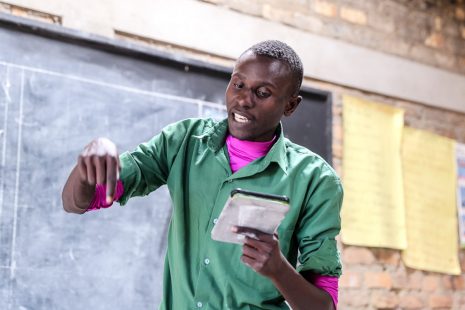Teachers with tech will replace teachers without tech
17 June 2019
Technology permeates all aspects of our economies, personal and professional lives and even our relationships. We live in the ‘Information Age’ which comes with some challenges but also some opportunities. To realise these opportunities we need to be—or become—literate in those technologies that drive bigger, better and more meaningful impact wherever they’re found.
Technology however comes with initial challenges; issues of automation, data usage and cost have meant that the development and implementation of technological innovations can be complex. Nowhere is this more true than in education.
Education is facing a crisis that has implications for security and prosperity both locally and globally. In low and middle-income countries the ability to tackle the crisis at scale will likely require the use of technological developments and yet there is a palpable reticence from many in the sector. Some have dismissed its benefits outright, whilst others have approached it cautiously, embracing it reluctantly. A small minority of new entrants are persisting with a technological approach to improving learning but the complex work is compounded by an antagonism to technology.
“Don’t focus on the device,” argues Tanyella Evans, COO of Library For All, adding: “Content is key.” Organisations like Bridge are using technology to deliver advanced pedagogy and teacher training and support but the focus is often on the device rather than the content within. Designed to function in areas of limited connectivity, the Bridge technology works in classrooms in low and middle-income countries where there is little support, learner materials or transparency. The device is an enabler of, not a replacement for, better teaching. The results speak for themselves.
Many—particularly union leadership—have incorrectly assumed that technology is intended to replace or undermine their profession; rather than support and enhance their work. As with all industries, technology and the effective use of data is enabling work to be done more efficiently and more effectively. In communities where children leave school unable to read and write; condemned to the poverty cycle in which they are trapped, harnessing the power of technology to change these outcomes seems obvious. Yet for many, it is not. The Brussels based teachers union Education International does not even have a policy position on the question of technology. It is not listed under their areas of work in spite of their stated priority to: “Initiate and lead a global conversation on the future of the teaching profession.” This unwillingness to engage and countenance the benefits that technology could offer both teachers and learners is damaging to those currently being failed.
Technology and teachers, not technology or teachers

As Michael Trucano (Senior Education and Technology Policy Advisor + Global Lead for Innovation in Education at the World Bank) points out, teachers will never be replaced by technology. Rather, “technology makes the role of the teacher more central and more important.”
Consequently, “over time teachers who know how to use technology will replace those who do not.”
Trucano concludes that the more pertinent question to consider is: “How can we use new technologies to support teachers in teaching?”
At Bridge, we’re interested in applying this question directly to the global learning crisis, and helping those access quality education in underserved communities around the world. With 263 million children out-of-school today, and a further 387 million in schools but not learning, all possible routes to solve this must be explored, this includes the opportunities presented by technology.
How can we use technology to support teachers?
A recent World Bank study found that only 7% of teachers have the minimum knowledge needed to teach reading and writing effectively. In countries where teachers are themselves a product of a poor education system, who then to on to teach in classrooms without support, this is not surprising. At the same time, half of all classrooms inspected in the study found no teacher present at all, making learning impossible. In isolated classrooms with limited resources and training; technology is an effective way of overcoming issues such as struggling teachers and absenteeism.
True to the words of Tanyella Evans above, technology is integral to the Bridge approach to teacher support. Our local academic teams create lesson plans that are then delivered to teacher computers, which are then used in the classroom. This minimises the administrative burden for our teachers, allowing more time for one-on-one engagement with their pupils. The technology raises the floor, enabling teachers who do struggle with particular aspects of a lesson, to have the resources and the support to overcome that struggle and teach it effectively. It gives all teachers access to world-class pedagogical approaches for teaching individual pieces of content. In addition, the technology enables us to know how children are doing; how much of the lesson is being taught, what content blocks children are struggling with. Teacher and pupil attendance, lesson completion and comprehension is recorded and analysed to improve learning and support.
Teachers and school leaders alike praise the technology: “I wish to encourage communities to learn about the technologies Bridge is teaching,” says Jennifer Ayebazibwe, head teacher at Bridge, Abaita Ababiri in Uganda, “We need to embrace it.”
Technological literacy will be a key skill for teachers in the future
Utilising technology to improve educational outcomes is inevitable. Embracing technology is necessary, if we are serious about achieving SDG4 and tackling educational inequality.
Michael Trucano’s calculation that: “Teachers who know how to use technology will replace those who do not,” seems very accurate. Technology must be embraced in low and middle income education systems, both in how teachers teach and in the way they way they are supported. Doing so will strengthen teachers, classrooms and learning; offering a pathway to security and prosperity.
Education systems that continue to resist technology are only delaying the inevitable and damaging learning outcomes.









